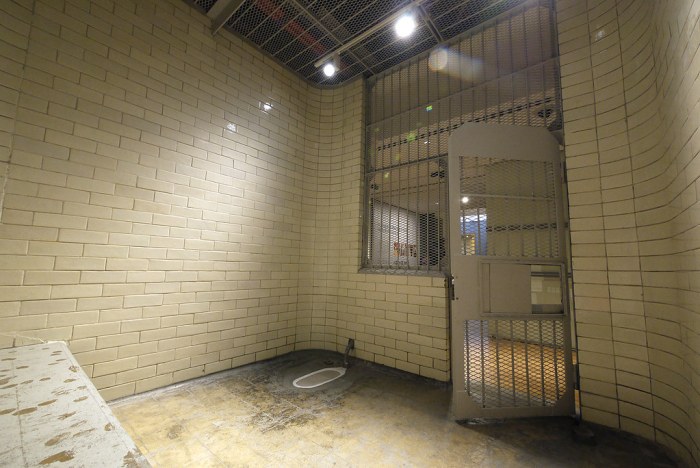What’s a holding cell? In the realm of criminal justice, it’s a temporary place of confinement for individuals awaiting processing, trial, or transfer. Holding cells serve as a crucial component of the criminal justice system, ensuring the secure and humane detention of individuals while respecting their rights.
This article delves into the concept of holding cells, exploring their types, procedures, conditions, health implications, legal ramifications, and alternative approaches. Join us as we uncover the intricacies of this essential aspect of the criminal justice system.
What is a Holding Cell?

A holding cell is a temporary detention facility used by law enforcement to hold individuals who have been arrested or are awaiting trial. Holding cells are typically located within police stations or courthouses and are designed to provide secure and short-term confinement.
The primary purpose of holding cells is to provide a secure location for individuals who are in police custody. This may include individuals who have been arrested for minor offenses, such as disorderly conduct or traffic violations, as well as those who are awaiting a court appearance or transfer to a jail or prison.
Types of Holding Cells

There are several different types of holding cells, each with its own characteristics and uses:
- Temporary Holding Cells:These cells are typically used for short-term detention, lasting a few hours or days. They are usually located within police stations and are used to hold individuals who have been recently arrested or are awaiting a court appearance.
- Long-Term Holding Cells:These cells are designed for longer-term detention, typically for individuals who are awaiting trial or transfer to a jail or prison. They are usually located within courthouses or jail facilities and may have more amenities than temporary holding cells.
- Isolation Cells:These cells are used to hold individuals who are considered to be a risk to themselves or others. They are typically smaller and more secure than other types of holding cells and may have limited amenities.
Procedures and Regulations: What’s A Holding Cell

The procedures for placing individuals in holding cells vary depending on the jurisdiction. However, there are some general standards that are typically followed:
- Individuals are typically arrested by law enforcement officers and transported to a police station or courthouse.
- At the station or courthouse, individuals are processed and booked into the holding cell. This includes providing personal information, fingerprints, and photographs.
- Individuals are then placed in a holding cell until they are released, transferred to a jail or prison, or appear in court.
There are also a number of legal regulations and ethical considerations surrounding the use of holding cells. These regulations ensure that individuals are treated fairly and humanely while in custody.
Conditions and Standards

The physical conditions of holding cells vary widely depending on the jurisdiction and the type of holding cell. However, there are some minimum standards that are typically required:
- Holding cells must be clean and sanitary.
- Holding cells must be adequately ventilated and have a comfortable temperature.
- Holding cells must have adequate lighting.
- Holding cells must have access to basic necessities, such as food, water, and toilet facilities.
In addition to these minimum standards, some holding cells may also have additional amenities, such as televisions, books, and games.
Questions and Answers
What is the primary purpose of a holding cell?
To provide temporary confinement for individuals awaiting processing, trial, or transfer.
What are the different types of holding cells?
Temporary holding cells for short-term detention and long-term holding cells for extended periods.
What are the minimum space requirements for holding cells?
Varies depending on jurisdiction, but generally around 30-40 square feet per person.
